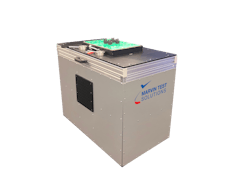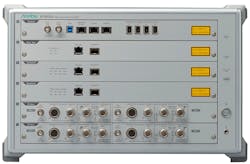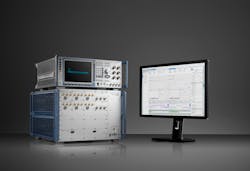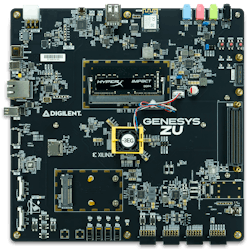Test-equipment vendors are keeping pace with rapidly evolving technologies, including 5G, Wi-Fi 6, and vehicle-to-everything (V2X). Measurement chores extend from testing small devices to massive MIMO antenna arrays. Products available include dedicated communications-test platforms as well as general-purpose instruments that can be adapted for specific communications technologies. Software also has a role to play in bringing together effective communications test solutions.
Challenges
According to Craig Hendricks, market development manager at Anritsu, “Our customers are designing products utilizing new technologies with evolving standards, so they need test solutions that can verify performance efficiently.” He added that Anritsu is involved in the standard organizations to stay current with the necessary tests. “We use that knowledge to develop test modules and software that address emerging technologies such as 5G NR and Wi-Fi 6 for our flexible product platforms to provide customers with the necessary support,” he said, explaining that Anritsu solutions can conduct RF, functional, and protocol tests.
Adam Smith, LitePoint’s director of product marketing, commented on the proliferation over the last few years of new global spectrum availability. “Of particular note are the licensed 5G FR2 mmWave bands (today at 24 to 40 GHz, and continuing to expand) and the ‘6 GHz’ unlicensed band (5.925 to 7.125 GHz). These frequencies are outside of the under-6 GHz ‘comfort zone’ of the majority of consumer wireless technologies, and require the makers of products using these bands to tool with new equipment.”
Smith continued, “This is particularly true in the manufacturing space, as the installed base of test and measurement equipment does not support these higher frequency bands. Product companies are finding themselves in need of bringing leading-edge technology to market, while also needing to keep the production economics in line with established price points for consumer products. Additionally, companies need to quickly adopt these technologies and be able to produce devices with high quality and high production yield.”
The second challenge, Langlois said, relates to characterizing RF hardware for 5G applications. “Concurrent to system modeling, the RF engineer must characterize the RF performance of candidate hardware platforms for a given application, he said. “For new and evolving standards like 5G, this characterization task is made more complicated as system requirements will likely evolve along with the standard. This places additional burdens on the characterization process, as it needs to be flexible enough to deal with shifting requirements.”
Complicating the characterization task even further, he said, is the advent of silicon devices with high levels of system integration, such as the Xilinx Zynq UltraScale+ RFSoC with integrated multi-gigasample-per-second RF data converters. “For these complex devices, access to the data converters can only be achieved through the processing subsystem, which may put an RF engineer used to working with discrete converters on a workbench into unfamiliar territory, as accessing the RF components will now involve some level of FPGA and embedded processor software design,” he said.
Langlois said that meeting these challenges requires a development environment that provides flexible signal generation and analysis for 5G standard-compliant waveforms, as well as for new waveforms as the standards evolve. “The generation and analysis capability must also be able to communicate with the hardware in a way that allows RF engineers to concentrate on the RF performance of the hardware, and not worry about programming embedded devices,” he said. “To ensure a seamless workflow between system-level exploration and RF characterization, the development system should include a proven pre-engineered RF front end allowing capture of real-time signals over-the-air which can serve as stimuli to drive the system model.”
Jeffrey Phillips, head of automotive marketing at NI, commented on the challenges of testing V2X devices. He first cited constant changes in underlying technology and new standards, which create changes in test needs. “Speed is creating a challenge in test,” he said. “Customers can’t buy systems fast enough, so we help them ‘buy’ an integrated test system that they can still edit/upgrade over time.”
Phillips next commented on system integration. “Connectivity is a critical component of autonomous vehicles,” he said. “Validating the entire system means bringing together hardware, software, and communication from multiple vehicle domains.”
He also addressed a software-connected approach. “Systems are built to the customer’s need, but done so on top of open, reconfigurable software running on modular, flexible, COTS-based hardware,” Phillips said. “They can evolve the tester as the test requirements evolve, meaning smaller upgrades to systems. We’ve seen this approach reduce the time to build a tester by 50%, 70%, 80%.”
When asked what challenges customers are facing, Reiner Stuhlfauth, wireless technology manager at Rohde & Schwarz in Munich, responded, “Let me reply to this question with two major aspects: the past and the future. We enable technologies, thus we have to deliver test solutions covering the forefront of technology evolutions. In close contact with our customers, we try to anticipate testing needs. This is the look into the future.”
Stuhlfauth continued, “The introduction of new technologies does not stop the evolution of existing technologies. This is the look into the past, as we fully need to support legacy technologies.” He added that the company’s solutions need to cover a wide range in terms of both technology and application. “To give an example in terms of technology: mobile radio technology today ranges from 2G to 5G and includes non-cellular technologies like Wi-Fi 6, UWB or Bluetooth,” he said, adding that with respect to the application, those RAT technologies are subject to R&D test, conformance test, and production test, “…so our solutions need to cover a wide application range as well.”
Stuhlfauth said that with the introduction of 5G NR, the test-and-measurement world sees a paradigm change. “The connection between DUT and system simulator becomes over the air,” he said. “Even if OTA testing is not new, it has become more important as it’s a pivotal element of an everyday test set up. With a wide range of OTA antenna testing and chamber portfolio, Rohde & Schwarz supports an easy upgrade of conducted to OTA, and integration of shielding chambers into the measurement setup for all possible devices, ranging from a single component via complete device up to a full vehicle.”
According to Amr Haj-Omar, market segment leader for wireless communications at Tektronix, circuit density on RF chips is exploding because of integrated antennas on a single chip and MIMO requirements. “Bandwidths on these devices are also going up,” he said. “The unique challenge of multiple channels at a wide bandwidth is something that has been difficult not only for chip designers, but also for test instrument vendors. Tektronix is uniquely positioned in this area, because of in-house ASICs that address both multiple channels and wide bandwidths.”
Products
Hendricks at Anritsu commented on several products and enhancements that address next-generation communications technologies including Wi-Fi 6, 5G, and V2X. “The Wireless Connectivity Test Set MT8862A WLAN tester has been enhanced to support RF TRx characteristics of IEEE802.11ax Wi-Fi 6 devices,” he said. “By using the MT8862A Network Mode, RF TRx characteristics, such as Tx power and modulation accuracy (EVM), can be measured with the Wi-Fi 6 devices in realistic operating conditions,” he said. “The MT8862A can simulate access points (AP) and stations (STA) to establish the DUT network connection using IEEE802.11a/b/g/n/ac/ax WLAN protocol messaging, allowing it to measure devices utilizing any Wi-Fi generation.”
Hendricks also said Anritsu’s recently-released LTE-V2X Tx Measurement MX887068A software for its Universal Wireless Test Set MT8870A enables it to measure Tx power, frequency deviation, occupied frequency bandwidth, and adjacent channel leakage power, as well as conduct spectrum emission mask test and modulation analysis as specified by 3GPP. “The bundled LTE-V2X Waveforms MV887068A package includes general RF test-signal waveform files required for non-signaling Rx testing for easy output of RF test signals, simply by selecting the waveform file,” he said. “The MT8870A, specifically designed for high-volume manufacturing environments, can also be used in R&D. It supports 5G NR sub-6-GHz, LTE, NB-IoT, Cat-M, WLAN up to 11ax Wi-Fi 6, and Bluetooth up to v 5.0.”
In addition, Anritsu recently introduced its SmartStudio NR (SSNR) environment for interactive GUI-based functional 5G device testing. “With a built-in, state-machine-based GUI, SmartStudio NR emulates the network conditions and communication between a 5G/LTE network and mobile terminal to implement efficient functional, application, and software regression tests,” said Hendricks. “Among the tests supported by SmartStudio NR are network connectivity and carrier aggregation; power consumption and temperature; IP throughput; messaging/IMS; and applications using an Internet-connected test server and real application server.”
Hendricks said Anritsu offers modular, flexible solutions that address current needs while providing a cost-efficient path to the future. “A perfect example is the MT8000A, a one-box solution that can conduct tests for 5G non-standalone (NSA) and standalone (SA) technologies, based on designated modules and software to support future 3GPP 5G releases.”
Rohde & Schwarz has introduced several solutions covering all areas of testing 5G, Wi-Fi 6, and automotive V2X technologies, according to Stuhlfauth, adding that the new solutions represent a steady evolution. “One example to point out is the introduction of a revolutionary operating concept for mobile radio testers, R&S CMsquares. It offers not only a web-based operation of the 5G radio tester R&S CMX500, but allows the configuration of 5G tests ranging from an interactive mode up to a sequencer and Python scripting mode for advanced testing.” The solution covers both the FR1 and FR2 5G frequency ranges, he added.
“Another example is the antenna test solution R&S PWC200,” Stuhlfauth said. “It is rooted in the longstanding idea of using a massive MIMO antenna array, not for the purpose of beamforming but as a method to generate a plane-wave zone in a short distance. Moreover, this OTA testing method reduces FAC (full anechoic chamber) size significantly and has recently been approved by the standardization body 3GPP as a plane wave synthesizer concept for base-station conformance testing.”
Stuhlfauth also mentioned the R&S CMW platform, which he described as the first wireless communication tester supporting Wi-Fi 6 in full signaling mode. “Now it also supports the 6-GHz frequency range,” he said. “And for automotive V2X applications, we have extended RF and signaling testing with higher-layer application testing for LTE based C-V2X. We are able to offer this solution based on the R&S CMW thanks to our partner Vector, who contributed their CANoe .Car2x solution.”
He elaborated on the R&S CMW test platform, saying that it together with the R&S CMX extension covers not only the mobile radio technologies from 2G to 5G, but also noncellular technologies. “It’s the first tester supporting Wi-Fi 6 signaling, the first tester supporting location-based services on 5G, and the first tester supporting LTE C-V2X signaling and application testing,” he said. “It’s the mobile radio tester with the highest number of 2G to 5G test cases, including LTE-M and NB-IoT. The operating concept with R&S CMsquares using a single user-interface for wide-based application range mobile-radio testing, and the R&S Contest for protocol and RF conformance testing, sets the optimized GUI for each purpose. The internal fading solution for signal generators and mobile radio testers reduces hardware size and cost.”
Finally, Stuhlfauth commented on the trend toward software as a service and cloud integration, explaining that Rohde & Schwarz has introduced server- and cloud-based testing as two solutions bringing the virtual world into the test and measurement space. “Server-based testing offers dedicated application-specific functionality in a customer environment, allowing the configuration of repetitive and automated procedures, while improving speed and integration complexity,” he said. “Cloud-based testing offers R&S test software as a cloud-based service, making access possible anytime and anywhere. Users benefit from a lower total cost of ownership.”
To help meet the challenge, “MTS recently introduced a mmWave/5G production test system capable of supporting the testing of 50-GHz devices,” Semancik said. “The system integrates laboratory-grade RF instrumentation with a high performance DUT-instrument interface to support the testing of mmWave devices for multisite production test or device characterization. The system also includes digital and parametric test capabilities as well as SPI/I2C interface support to functionally control and monitor the device under test. For production test applications requiring integration with an automated handler, the TS-900e-5G is available with an inTEST manipulator which provides precise positioning of the test head, and the flexibility to interface to automated probers and device handlers. The TS-900e-5G's device interface board (DIB)/receiver interface is designed to be compatible with virtually any device handler.”
Smith at LitePoint said the company’s products typically serve the product development (R&D), design characterization (DVT), and high-volume manufacturing phases of a wireless product’s life cycle. “The wireless markets that we service are in various stages of maturity, and the focus of our latest products is subtly different depending on the market,” he said. He cited as an example the IQgig-5G Model B. “In 2019, we saw the introduction of early 5G products in the market,” he said. “In 2020, we are on the cusp of the high-volume ramp for 5G end-products. The IQgig-5G is currently helping device makers scale their mmWave 5G products to volume manufacturing.”
He also commented on the IQxel-MW 7G. “The last time that a GHz of unlicensed spectrum was made available for use was over 20 years ago,” he said. “The IQxel-MW 7G is in heavy use in R&D and product characterization (DVT) teams, helping to bring new Wi-Fi 6E products to market later this year that take advantage of the new 6 GHz unlicensed band.”
NI helps customers meet the challenges of cellular V2X test with its recent introduction of a solution for characterizing C-V2X chip performance in the lab. “The C-V2X Open Loop Test System helps our customers validate the functionality of their V2X applications, whether based on EU, US, or Chinese regional standards,” said Phillips. “With a flexible, software-connected architecture, this solution reduces the risk in adapting to continually-evolving technologies.”
Phillips continued, “NI’s electronics test background allows us to learn from and connect challenges across industries. Our test systems span the entire design cycle. Our breadth of measurement and control capabilities mean we provide flexibility and performance across the measurement needs, which are now converging in the connected vehicle.” He added that NI offers coverage across vehicle domains—“EV, ADAS, connectivity, infotainment, and the entire design cycle.”
Phillips said NI helps its customers protect their investment in test solutions by being open. “That’s how we keep pace with the entire spectrum of technology changes,” he said. “We’re built on COTS processors and software capabilities. We can help our customers adapt faster with our approach to building systems. And our broad industry presence means we’ve been looking at 5G from a design standpoint for years.”
For communications applications, Avnet offers products such as their XRF16 RFSoC system-on-module, released in May 2020. Langlois described the XRF16 as a production-ready 16x16 direct-RF sampling module with 5 GHz analog bandwidth featuring the Xilinx Zynq UltraScale+ RFSoC Gen 2, with 16 RF-ADC and 16 RF-DAC channels. “The SOM is designed for integration into deployed RF systems demanding small footprint, low power, and real-time processing,” he said. “An XRF carrier card and comprehensive software suite are available for rapid prototyping, enabling you to develop application code for the XRF16 SOM that is ready for deployment when your custom carrier arrives.”
The company also offers the Avnet Zynq UltraScale+ RFSoC Development Kit, which Langlois said enables system architects to explore the entire signal chain from the antenna to the digital circuitry using tools from MathWorks and RF components from Qorvo. “We extend the functionality of the Xilinx Zynq UltraScale+ RFSoC ZCU111 Evaluation Kit by adding a Qorvo 2-channel RF front-end 1.8-GHz card for over-the-air transmission, plus native connection to MATLAB and Simulink with Avnet's RFSoC Explorer application. He described Avnet's RFSoC Explorer as “…a graphical interface that allows system designers and RF engineers to generate signals to the RFSoC hardware, and acquire signals from the hardware within the MATLAB environment.”
He continued, “As a heterogeneous computing platform, it offers a single-chip radio solution that can also implement a radio protocol stack, network functions and multimedia capabilities close to where they are needed. The Genesys ZU is a well-rounded prototyping platform for Xilinx Zynq UltraScale+ MPSoC. Radio front-ends and ADC/DACs can be easily interfaced through the FMC and Zmod connectors, while different modulation schemes and MIMO beamforming are implemented in the programmable logic. The integrated 2.4-GHz Wi-Fi and the Mini PCIe expansion option provide a good wireless connectivity base to compare custom implementations against.”
Asked what is unique about the solution, the spokesperson cited expandability and variety. “The Genesys ZU development platform takes the flexibility of the Xilinx Zynq UltraScale+ MPSoC and couples it with interface and connectivity flexibility,” he said. “It is a more general-purpose board, and we intentionally built it that way. That being said, you can find the different components and interfaces on the Genesys ZU in a variety of products, but the only place you can find ALL of them together is on the Genesys ZU.” In addition, he said, “The versatility of the Genesys ZU-3EG makes it a flexible solution that can adapt as communications standards continue to evolve.”
When asked about specific products, Haj-Omar at Tektronix cited the 6 Series mixed-signal oscilloscope and the release of a 2-GHz span for SpectrumView software; the latter allows customers to use the MSO6 as an analyzer for 5G and Wi-Fi 6 signals. “With the latest releases around Wi-Fi 6, customers need to be able to operate at up to 7.125-GHz center frequency, and the upper range of the MSO6 is 8 GHz,” making the instrument suitable for time-domain and RF measurements on 5G and Wi-Fi 6 devices.
“For V2X communications, Tektronix has introduced new capabilities in our low-cost USB RF portfolio,” Haj-Omar said. “Instruments such as the RSA306B, RSA500, and RSA600 provide ultraportable instrumentation for RF measurements. These instruments can be powered by USB, battery, or AC power, providing the flexibility that test engineers need for debugging RF signals. The C-V2X has a bandwidth of 20 MHz today, with a possibility of 40 MHz in the future. All USB RF instruments provided by Tektronix have a bandwidth of 40 MHz, making them ideal for C-V2X measurements.”
The distributor Saelig offers several products suitable for testing 5G, Wi-Fi 6, and other advanced communications technologies. CEO Alan Lowne reported that ThinkRF real-time spectrum analyzers are geared for 5G, and Saelig offers one 8-GHz model for less than $4,000. “Our SIGLENT and Rigol spectrum analyzers…go to 7.5 GHz, so would be useful for Wi-Fi 6 work.” He added that Saelig offers Triarchy USB modules which generate or analyze signals up to 8 GHz, and Windfreak modules that can generate signals up to 24 GHz.
A variety of special-purpose test sets, general-purpose instruments, and even thermal test platforms are now available, such as TotalTemp’s Model SD288 for fast, efficient testing of large or multiple RF modules, according to John Booher, chief technology officer. “We have new sizes of thermal platforms that by using the capability of conduction and liquid nitrogen (or advanced refrigeration systems) can quickly test emerging hardware to quickly automate and validate new hardware,” he said. “Our thermal platforms and hybrid benchtop chambers provide accessibility during test, speed, and ability to precisely test products at temperature with simple to use automation and logging features.”
EE-Evaluation Engineering’s August special report on signal and spectrum analyzers and our July special report on RF/microwave test provide additional information on products and techniques that can be applied to 5G, Wi-Fi 6, V2X, and other next-generation communications standards.
Indeed, several contributors to our RF/microwave test special report have elaborated on their solutions for advanced communications technologies.
For example, Rick Gentile, product manager, RF and signal processing systems, MathWorks, said the company launched its 5G Toolbox not long after the 5G NR standard was approved. “This was possible by working closely with companies directly tied to the standards process,” he said. “We have multiple standards-based products for wireless beyond 5G, including LTE, WLAN, and Bluetooth. These products are focused on standards compliance and interoperability.”
Gentile continued, “Our customers typically fall into one of the following categories: some teams want to ramp up on the standards quickly, and some teams that are already experts leverage our framework to further develop algorithms. Our toolboxes for wireless applications are all written in MATLAB. Anyone that has the toolboxes also has the code for all of the algorithms and building blocks. This allows our customers great insight into all aspects of the standards.”
Gentile said the company’s R2020a release, which became available in March, includes highlights such as Interactive Apps that help with common tasks, including the Wireless Waveform Generator App to connect 5G waveforms with commercially-available test equipment; support for 5G NR standards for modeling and simulation; RF propagation analysis and visualization in dense urban scenarios; modeling for large installation platforms and radar cross section analysis; multifunction RF modeling through tracking and resource scheduling; and automotive radar design for high-bandwidth systems.
According to Manohar Raju, senior product specialist at Ansys, the company’s tools serve in various verticals, including but not limited to 5G, Wi-Fi 6, automotive radar, and IoT. “Engineers use Ansys HFSS to model diversity and MIMO antennas appropriate for spatial beamforming in 5G and Wi-Fi 6 applications,” he said. “5G networks utilizing mmWaves rely on the performance of the user equipment (UE) and microcell (or base station) antennas and propagation channel. In addition to their EM and thermal performance, 5G UEs can be designed for biocompatibility and regulatory compliance. Ansys HFSS is used to virtually prototype and simulate human device interaction with UEs. Ansys Icepak is combined with HFSS to predict the thermal performance of the UEs. Our tools reduce the cost of regulatory and compliance testing.”
Raju further said that 5G can extend the scope of IoT to enable smart cities. “With virtual-city models in HFSS, engineers can simulate large dynamic wireless scenes combining appropriate solvers and extracting channel state information (CSI) between all antennas in the scene. The solutions give insights into a network’s physical channel performance and base station siting before field deployment—thus reducing the cost and time of producing physical prototypes and OTAs. These solutions (with CSI extraction techniques) exploit the potential of multiuser massive MIMO beamforming and adaptive beamforming approaches to design effective end-to-end 5G wireless networks and antenna systems. Raju also commented on automotive applications, saying Ansys tools simulate RFICs and the standalone and installed performance of radar, and engineers can virtually recreate dynamic ADAS scenarios involving V2V and V2X communications in Ansys HFSS SBR+.
Finally, Keysight Technologies spokespersons said Keysight’s 5G design and test solutions address the complete 5G mobile ecosystem, including chipsets, components, devices, base stations, and networks. “Our solutions are used across the workflow for each component—R&D, design validation, manufacturing, deployment, and monitoring, from the physical layer to the application layer,” they said. “Keysight partnered early with industry leaders to understand the complexities of 5G, and develop test cases for many different usage scenarios. Our end-to-end coverage generates new insights that accelerate 5G innovation across the device workflow.” They added that Keysight’s chipset and device solutions cover the following applications: waveform R&D, protocol R&D, RF automation, functional and performance testing, protocol conformance testing, RF/RRM conformance testing, carrier acceptance testing, and manufacturing test.
They also discussed automotive applications. “Keysight is deeply involved in test and development solutions supporting vehicle-to-everything (V2X) technologies that enable direct, real-time, and safe communication between vehicles, road users, and roadside infrastructure,” they said. “These technologies pave the way for the development of autonomous driving by enabling advanced driver assistance systems (ADAS) to work with V2X systems, eventually enabling self-driving cars.”
About the Author

Rick Nelson
Contributing Editor
Rick is currently Contributing Technical Editor. He was Executive Editor for EE in 2011-2018. Previously he served on several publications, including EDN and Vision Systems Design, and has received awards for signed editorials from the American Society of Business Publication Editors. He began as a design engineer at General Electric and Litton Industries and earned a BSEE degree from Penn State.





